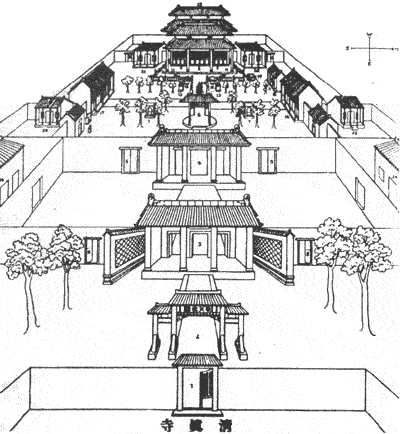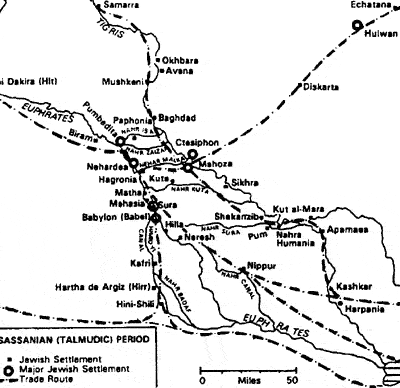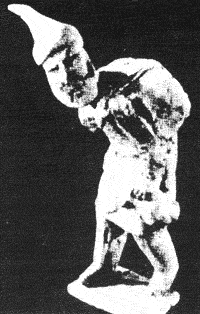The Silk Route; A Judaic Odyssey
Fact Paper 3
© Samuel Kurinsky, all rights reserved

For further details on Jewish silk making and dyeing see FP 15, Silk-making and the Jews; FP 21, Dyemaking, A Jewish Tradition; For other Jewish industries, crafts, and technologies see FP 4-I Iron-working, A Judaic Tradition; FP 6-I, Glassmaking, A Judaic Tradition, The Early Years; FP 6-II, Glassmaking, A Judaic Tradition, The Common Era, The Roman Period, FP 13-I, Craftsmanship a Jewish Tradition - The Archaic Period, FP13-II, Craftsmanship, a Jewish Tradition - The Biblical Period, and FP 13-III, Craftsmanship, a Jewish Tradition, The Roman Period.
One thousand seven hundred years before Marco Polo set out on his journey from Venice to China, Persian/Jewish traders pioneered the route from the Near East to Kaifeng, then the Capitol of Imperial China.
The first evidence of this significant historical milestone was recovered from the fifth century BCE grave at Lo-yang. Glass beads to wear in the next world were among the artifacts buried with the deceased. The Chinese had no knowledge of glassmaking at that time.1
The beads were typical of those made in Eretz Israel, the Land of Israel. They were overlaid with concentric rings of colored glass, and are termed "eye-beads." They were distributed around the Mediterranean by Canaanite seafarers (commonly referred to as "Phoenicians")

For the next thousand years, Jewish glassware and linens were the principal goods exchanged for the silk and spices of China and India.
Cinnamon, Cassia (the bark from which cinnamon is made), jade, camphor, and many other Chinese products were greatly in demand in the West. The earliest reference in any literature to the oriental products, cinnamon and cassia, occurs in Exodus 30:23: Moses is instructed to take "principal spices, of pure myrrh five hundred shekels, and of sweet cinnamon (kinamon besem) half so much." In 30:24 he is likewise instructed to take "of cassia (kiddah) five hundred shekels."
Herodotus (485-425 BCE) stated that the Greek word Kinnamomon came from Canaan (3.111). Likewise, the word in Exodus for cassia, kiddah, appears in Greek as Kitto. Another Biblical word, kes’iah (Psalms 45.9), became the Greek Kasia.2 The transcription of Aramaic words into the Greek language identifies the merchants who first brought these spices in the fifth century BCE from the Orient to the Mediterranean to be traded around that great sea.
Linen fabrics (Byssus) were as marketable in China as were silk fabrics in the west. One of the earliest centers of industrial weaving of fine linen fabrics was the city of Beth Shean. The Bible informs us that Beth Shean (called "Scythopolis" by the Greeks), was a Canaanite town which fell to the forces of David. By the third century BCE, the Jews of Beth Shean had achieved world fame as producers of fine fabrics. The Jerusalem Talmud refers to "the fine linen vestments which come from Beth Shean (Qiddushin ii, 5062c)."
The halachic sage, Rabbi Chiyya bar Abba, is among those mentioned in the Mishnah as involved with trade in the Near East. R’Chiyya dealt with three of the basic goods traded along the route into China: glassware, flax, and linen.
In a Latin work of the fourth century, Descriptus Orbis, Beth Shean is described as a city which supplies textiles to the whole world. The superiority of textiles and clothes made by Jews in Beth Shean was affirmed by the Roman Emperor Diocletian. In 296 CE, Diocletian decreed fixed ceilings on prices and wages throughout the Empire. The woven products of Beth Shean were listed in the top class.
The edict lists only two types of glassware. One was designated vitri Ijudaici (Judaic glassware, i.e., glassware made by the Jews of Judah), and vitri Alessandrini (glassware made in Alexandria). Another Roman emperor, Hadrian, asserts that Jews are the glassmakers of Alexandria. Thus the testimony of two Roman emperors designate the Jews as the world’s glassmakers in Roman times.3
R.Chiyya followed in the footsteps of his mentor, the great Rabbi Judah Ha-Nasi (135-219 CE). The involvement of other sages and Jews in pan-Asian trade, as reflected in the Mishnah, burgeoned as centuries passed by. The tradition of travel and trade expanded into a world-girdling network of Jewish trade under the Persian/Jews called the Rhadanites. Ibn Khurdadhibih, an Arab chronicler of the ninth century, wrote that "these merchants speak Arabic, Persian, Roman, Frankish, Spanish and Slavonic. They travel from East to West, and from West to East by land as well as by sea."4 Ibn might well have added Hebrew and Aramaic to the list of languages spoken by these intrepid travelers!

Augustus, the first Roman emperor, is said to have commissioned "the original travel guide" from Isadore of Charax, who obliged by writing The Parthian Stations. Charax was a port at the head of the Persian Gulf. The authoratiative historian, A. T. Olmstead remarks that "By this time we realize how incomplete was our knowledge of the (Persian] Empire when observed through the eyes of the Greek writers only... Rescripts from Persian kings were cited in Ezra."5
Evidence of Judaic influence along the route branching off from the cross-China passage into India was rendered by the militant Mauriyan emperor Asoka (c. 269-32 BCE), who became a Brahman after slaughtering (by his own admission), 100,000 innocents. Asoka marked his conversion of conscience by scrawling a series of edicts on rocks and pillars throughout India from the Bay of Bengal across the Indian sub-continent up into the heart of the Kush mountains in Central Asia. These pillars proclaim Buddhist precepts, exhorting Asoka’s subjects in quasi-commandment form to refrain from evil doings, to desist from disparaging their neighbors, to honor teacher, father, and mother, to treat slaves as dependents with compassion, to kill animals only for food, etc. These proselyting Buddhist exhortations are remarkable in two respects: The reflect Biblical commandments and the humanitarianism promulgated by the Judaic Babylonian sages of the time; and second, Aramaic is prominent among the languages in which they are inscribed. Most are in a combination of either Prakit (an Indic language) and Aramaic, some are in Greek and Aramaic, and some are entirely in Aramaic!


The trail of the traders along the route into Imperial China and India is marked with traces of Judaic passage. The startling discoveries of M. A. Stein in 1902 indicate that the art of glassmaking, uniquely Judaic at that ancient time, was practiced by itinerant artisans along the silk route. Included with glassmaking relics at one site was a fragment of a business letter written in Hebrew script, and a Hebrew prayer written on paper. Paper was then as yet unknown in the West; Its presence indicates that the traveler was traveling from East to West.7
The Judaic merchants learned about Chinese inventions, and introduced many of them into Europe. The first paper factory in Europe was established by a Jewish entrepreneur. The formula and use of explosive powder likewise became a uniquely Judaic intelligence, and remained so for a long time. The Medicis, and othe European overlords, employed Jews as munitions-makers.
The Rhadanites learned a new system of mathematics in India: the use of zero as applied in the decimal system. The Jewish trader-travelers wrote books in Aramaic on the system, and employed the decimal system in their dealings with the Arabs in North Africa. The symbols are now mislabeled "Arabic numerals."
In the Talmudic period up to two million Jews were concentrated in the heartland of Babylonia, the hub from which the trans-Asian routes radiated out to the East and West. The traffic passed through a complex of Judaic cities at the agricultrural and industrial center of Babylonia, cities in which great Judaic universities thrived. The trading posts that sprang up along the routes became bustling cities: Samarkhand, Bukhara, Taskent and others. Each town had a heavy population of Jewish artisans and merchants. In the twelfth century, A Jewish population of 50,000 was reported to be carrying on a flourishing business in Samarkhand alone.
By this time, the Jewish population of Kaifeng, the terminus of the silk route, was well established, and in 1163 an imposing synagogue was erected, accommodating a community of three thousand worshipers. Drawings of the synagogue made in the early eighteenth century by a Jesuit priest, Jean Domenge, show that it was the center of an extensive complex of buildings, gathered around a series of gardens. The synagogue was posted in the Jewish quarter of Kaifeng near the Huang Ho River. Several ancient Chinese drawings depict lengthy caravans heading out westward from this quarter across a bridge spanning the river .
Not even Marco Polo’s father, in whose footsteps Marco presumably trod, had as yet arrived in China.
Notes
A full exposition and extensive bibliography on the Persian (Sassanian) hub of the "Silk Route" and the "Silk Route" itself is given in chapter 8 and chapter 9 of The Glassmakers; An Odyssey of the Jews. The book is available [Catalog of HHF Literature] from the Hebrew History Federation Ltd.
For further information about Jews in China and the Kaifeng community see Sidney Shapiro, Jews in Old China, Hippocrene Books, NY, 1938
- C. G. Seligman, "Early Chinese Glass," Trans. Of the Oriental Ceramic Society, 1940-41, 20-21.
- Lionel Casson, Ancient Trade and Society, Wayne State Un. Press, 1984, 226.
- Dan Barag, "Recent Epigraphic Discoveries Related to the History of Glassmaking in the Roman Period," Annales du 10th Congress, Madrid-Segovia, 1985, 113-116.
- Ibn Kurdadhibbih, The Book of the Routes and Kingdoms.
- A. T. Olmstead, The History of the Persian Empire, Un. Of Chicago Press, 1948, ix xv.
- Louis Dupree, Afghanistan, Princeton Un. Press, 1973/80, 272-287; Herzfeld, A New Asoka Inscription from Taxila," Epigraphica Indica, 1928, xix, 251; R. Majundar, H. Rechaudhuri, and K, Datta, An Advanced History of India, 1961, 101-102; W. Henning, "The Aramaic Inscription of Asoka in Lamaka," Bull. of the School of Oriental and African Studies, 1949-50, 13:80-88; H. Bailey, "Gandhan" Bull. of the School of Oriental and African Studies, 1943, 46.
- M. Aural Stein, "A Journey of Geographical and Archaeological Exploration in Chinese Turkestan", The Geographical Journal, 1902; "Sand-buried Ruins of Khotan," 1903; Serinda, Oxford, 1921; "Central Asian Relics of China’s Ancient Silk Trade, Hirth ann. Vol. 1821; On Ancient Central Asian Tracks, London 1933.
